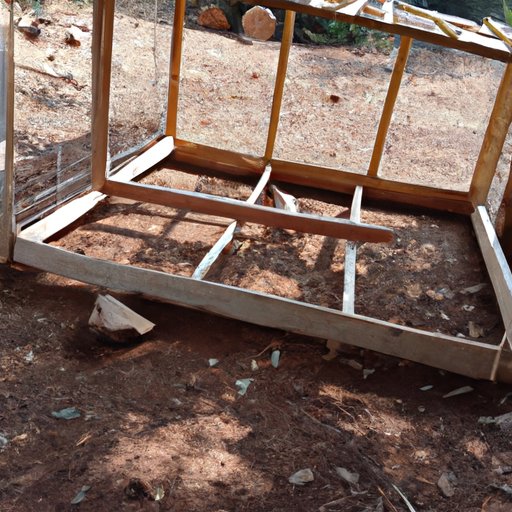Introduction
Raising chickens can be a great way to enjoy fresh eggs and provide your family with high-quality protein. Having your own chicken coop is essential for providing a safe, secure environment for your birds. Building a coop requires some planning and preparation, but the end result will be worth it.
This article provides an overview of the steps involved in starting a chicken coop. We’ll discuss the research required, such as understanding the requirements for a healthy chicken coop and learning about local laws and regulations. We’ll also cover the actual construction process, from designing the layout of the space to selecting the right building materials and assembling the structure. Finally, we’ll discuss how to equip the coop with the necessary supplies and prepare it for your chickens.
Research the Basics
Before you start constructing your chicken coop, it’s important to do your research and understand the requirements for a healthy, functional chicken coop. According to a study by the University of Minnesota Extension Service, “A well-constructed and managed chicken coop offers protection from predators, extreme weather conditions, and other hazards.”
The first step is to learn about local laws and regulations regarding chickens. You may need to obtain permits from your local government before you start building. It’s also important to understand any zoning or housing restrictions that may apply to your property.
Create a Plan
Once you’ve done your research, you’re ready to start creating a plan for your chicken coop. Consider the size, shape, location, and climate of the space where you plan to build. The size of the coop should be determined by the number of chickens you plan on keeping. You’ll want to make sure the coop is large enough to accommodate them all comfortably.
Design the layout of the space and decide what type of features you want to include. Make sure the coop has adequate ventilation and insulation to keep your chickens warm and comfortable in cold weather. Consider adding windows for natural light and a door for easy access.
Select Appropriate Building Materials
Once you have a plan in place, it’s time to select the appropriate building materials for your coop. Choose a durable material that can withstand both hot and cold temperatures. Common materials used for building chicken coops include wood, metal, plastic, and brick.
You’ll also need to determine which tools and supplies you’ll need to complete the project. These might include nails, screws, saws, hammer, drill, and other basic carpentry tools. Make sure you have all the necessary components before you begin building.
Assemble the Coop Structure
Now you can start assembling the structure of the coop. Follow the instructions provided by the manufacturer or plans you’ve created. Secure the frame with nails or screws to ensure it is sturdy and stable. Once the frame is complete, add the walls and roof.
Make sure to leave enough room for a door and windows. If you are using wood, seal it with waterproof paint to protect it from moisture. You may also want to add a ramp so your chickens can easily enter and exit the coop.
Equip the Coop with Necessary Supplies
Once the structure of the coop is complete, it’s time to equip it with the necessary supplies. Install roosts, nest boxes, and feeders. Make sure the roosts are at least two feet off the ground and placed away from the walls to reduce the risk of frostbite. Nest boxes should be placed near the roosts for easy access.
Add insulation to the walls and floor to help keep the coop warm in winter. Make sure the coop is well-ventilated to prevent the buildup of ammonia fumes from droppings. Add a window or two for natural light and air flow.

Prepare the Coop for Chickens
Before you bring your chickens home, you’ll need to prepare the coop for their arrival. Cover the floor with straw or wood chips to provide a comfortable bedding area. Place nesting boxes inside the coop and fill them with straw or shredded paper.
Put up fencing around the coop to keep out predators. Make sure to use heavy-duty fencing that won’t be easily damaged. Add predator-proofing to the exterior of the coop, such as hardware cloth or electric fencing.
Conclusion
Starting a chicken coop requires some research and planning, but the end result is worth it. Knowing the basics of how to start a chicken coop can help you create a safe and secure environment for your birds. With the right materials and supplies, you can build a functional, long-lasting chicken coop that will provide your family with fresh eggs for years to come.
We hope this article has given you an overview of the steps involved in starting a chicken coop. Now it’s time for you to get started on your own project!
(Note: Is this article not meeting your expectations? Do you have knowledge or insights to share? Unlock new opportunities and expand your reach by joining our authors team. Click Registration to join us and share your expertise with our readers.)
